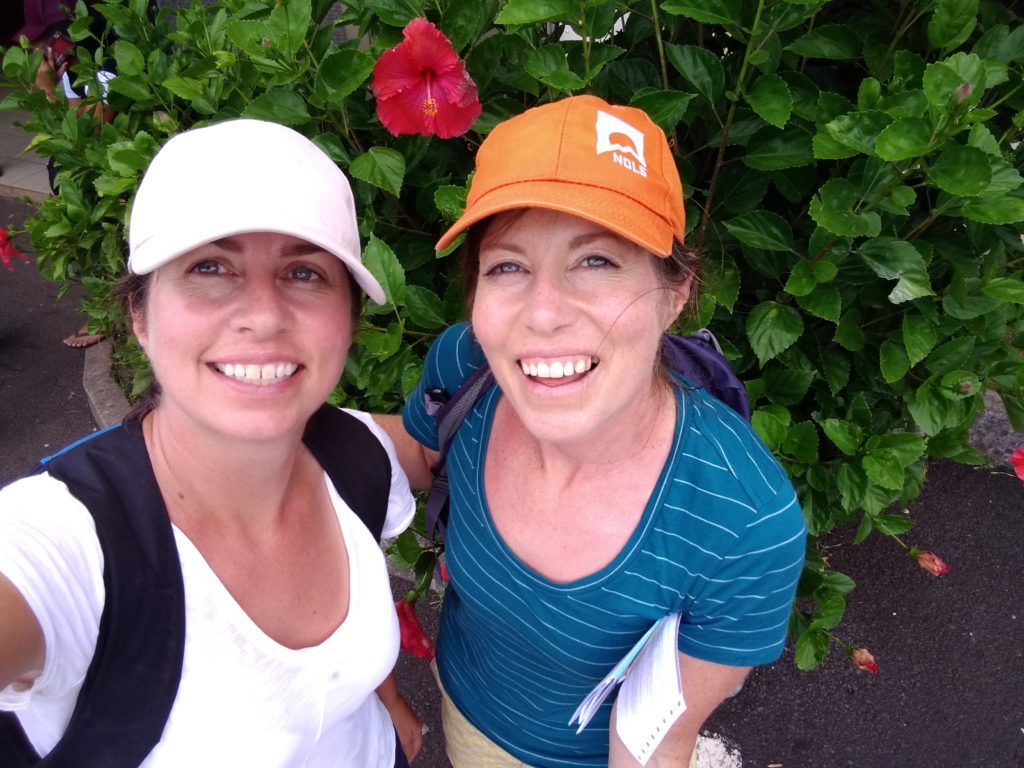
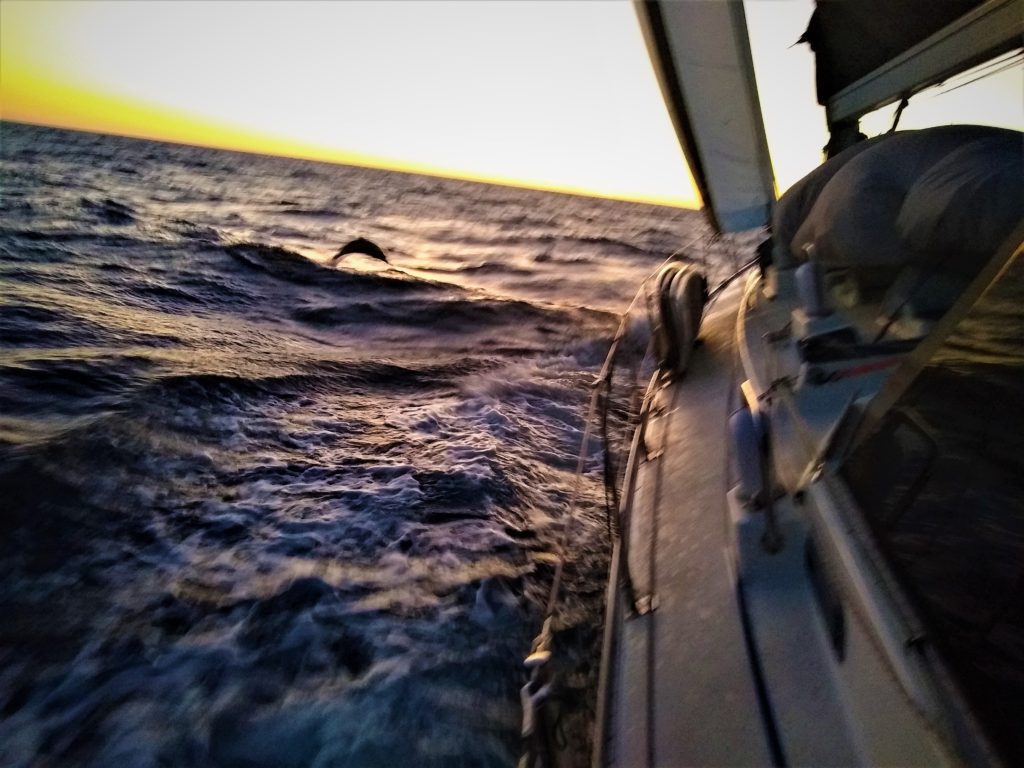
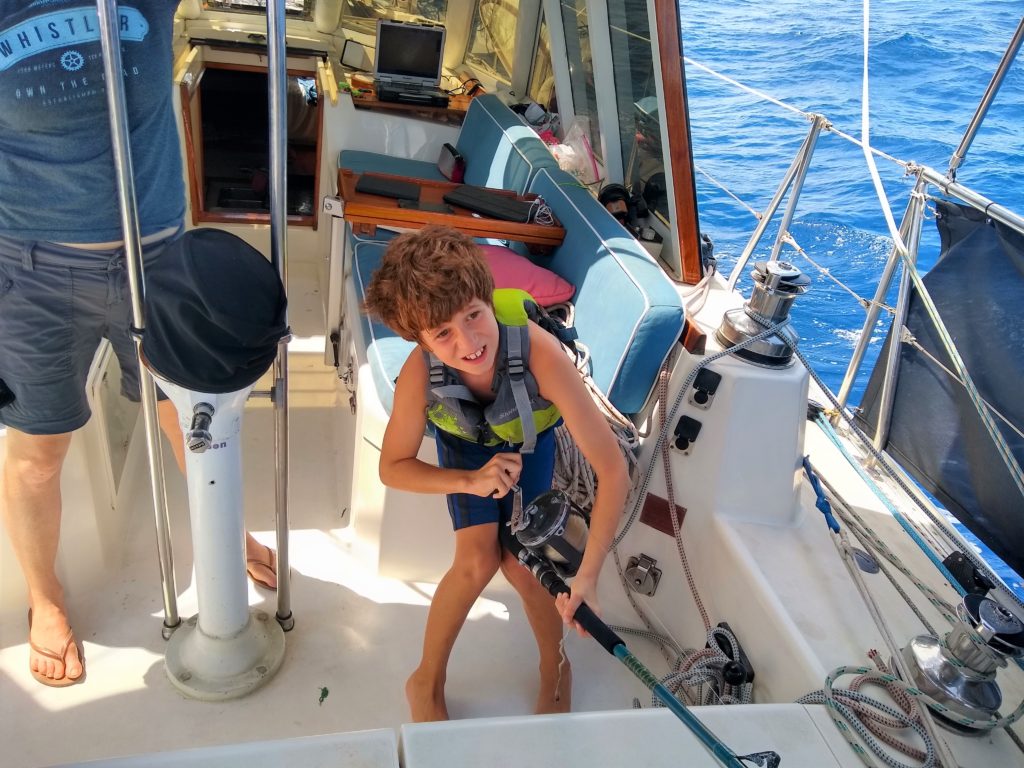
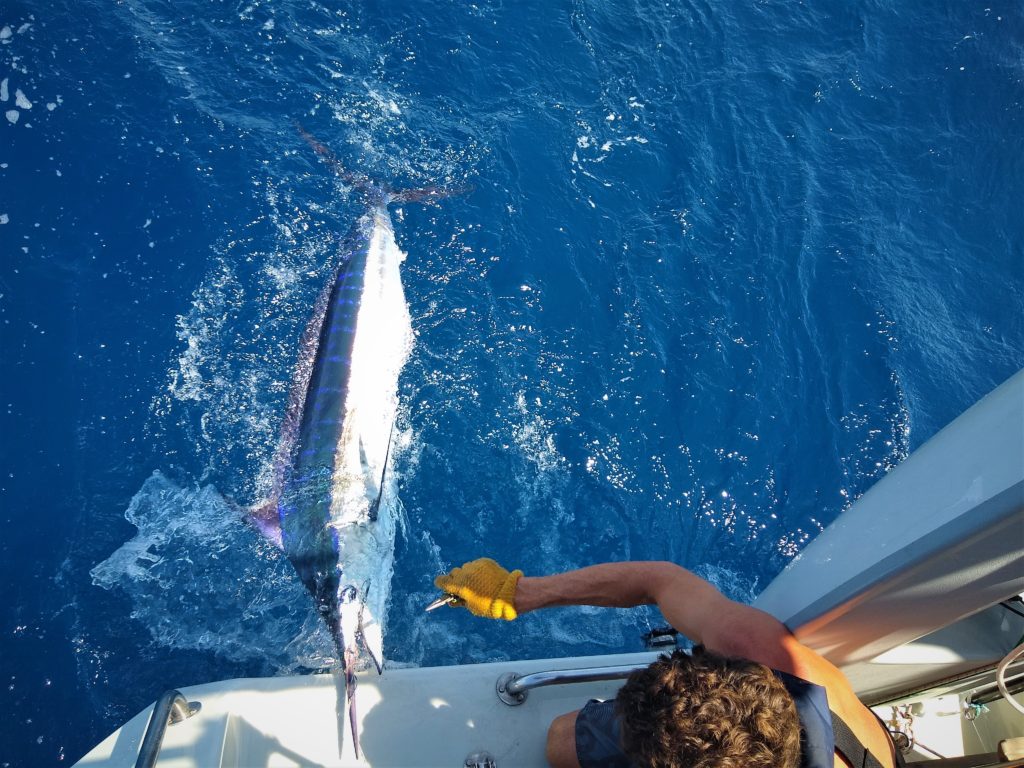
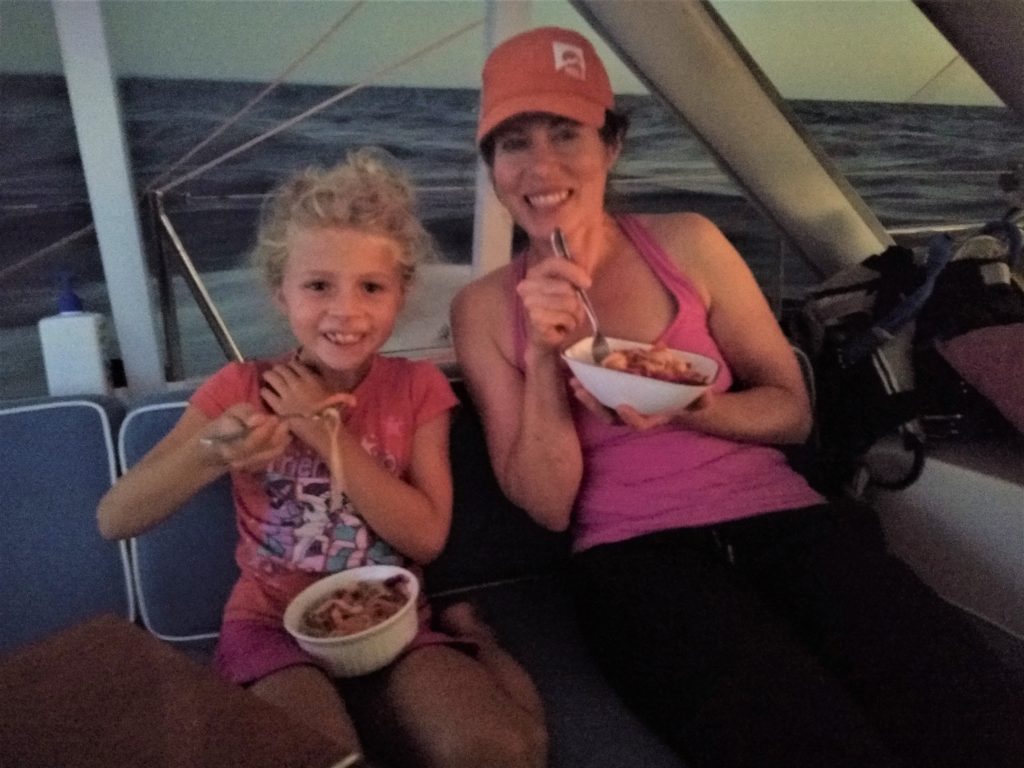
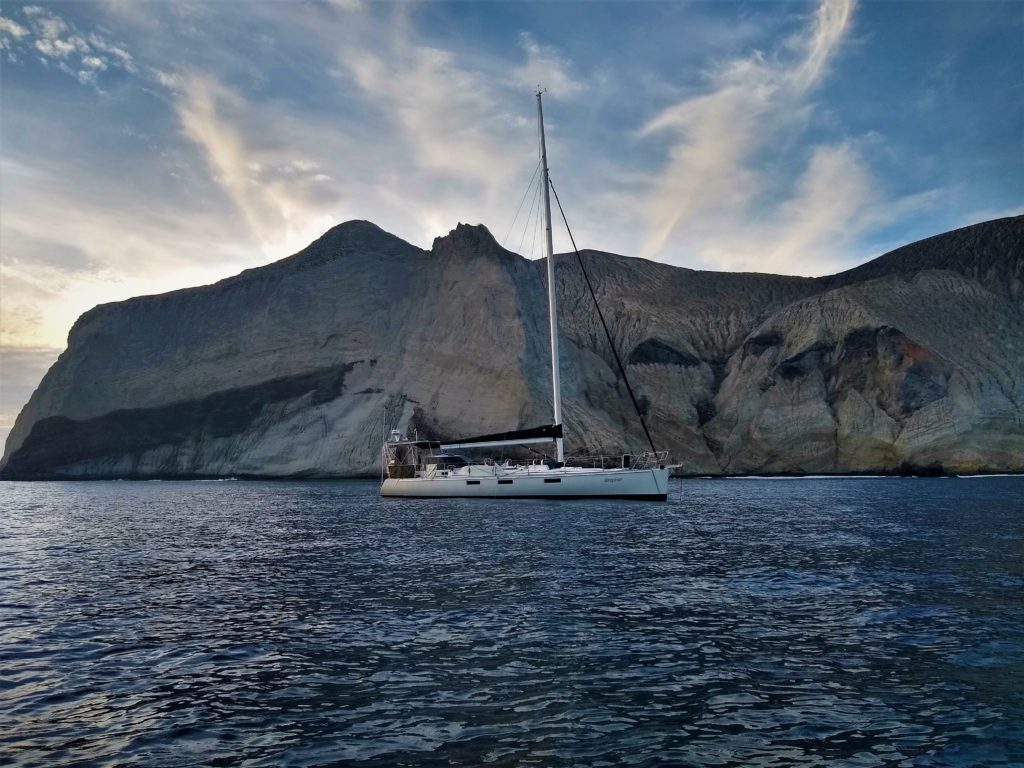
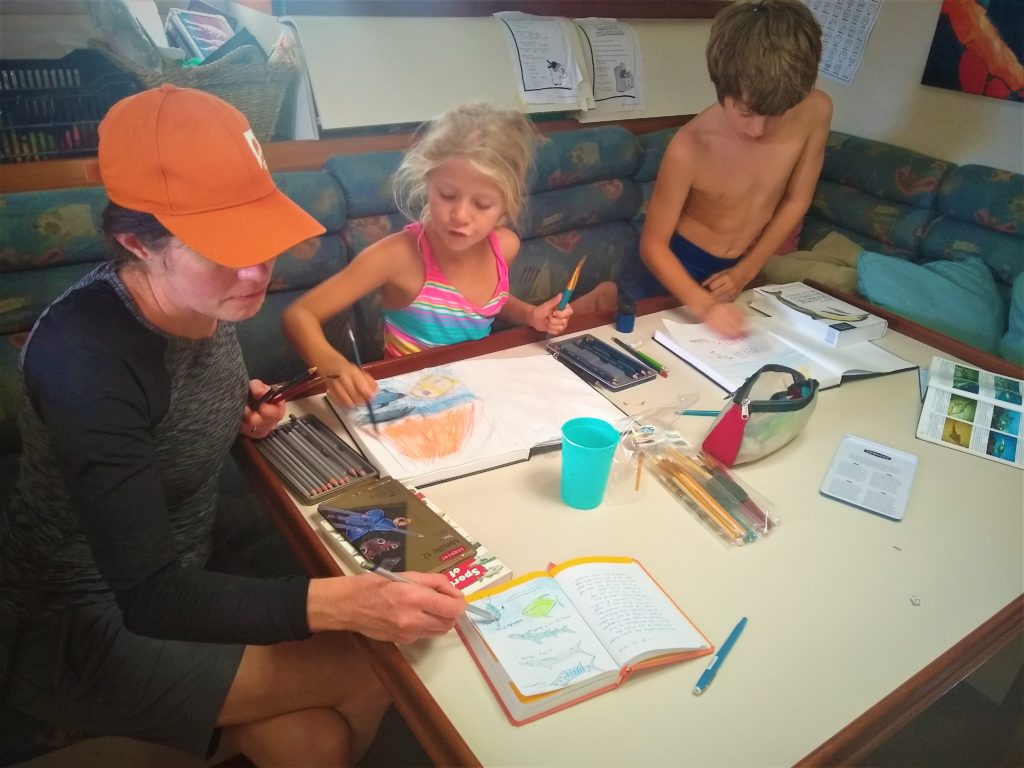
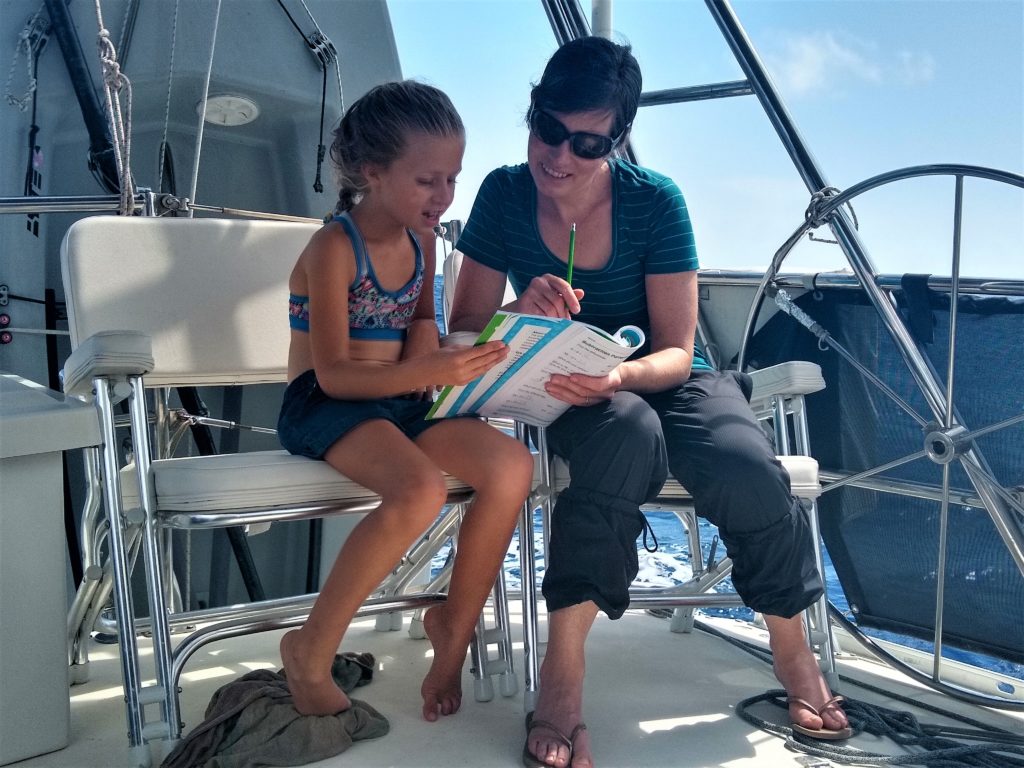
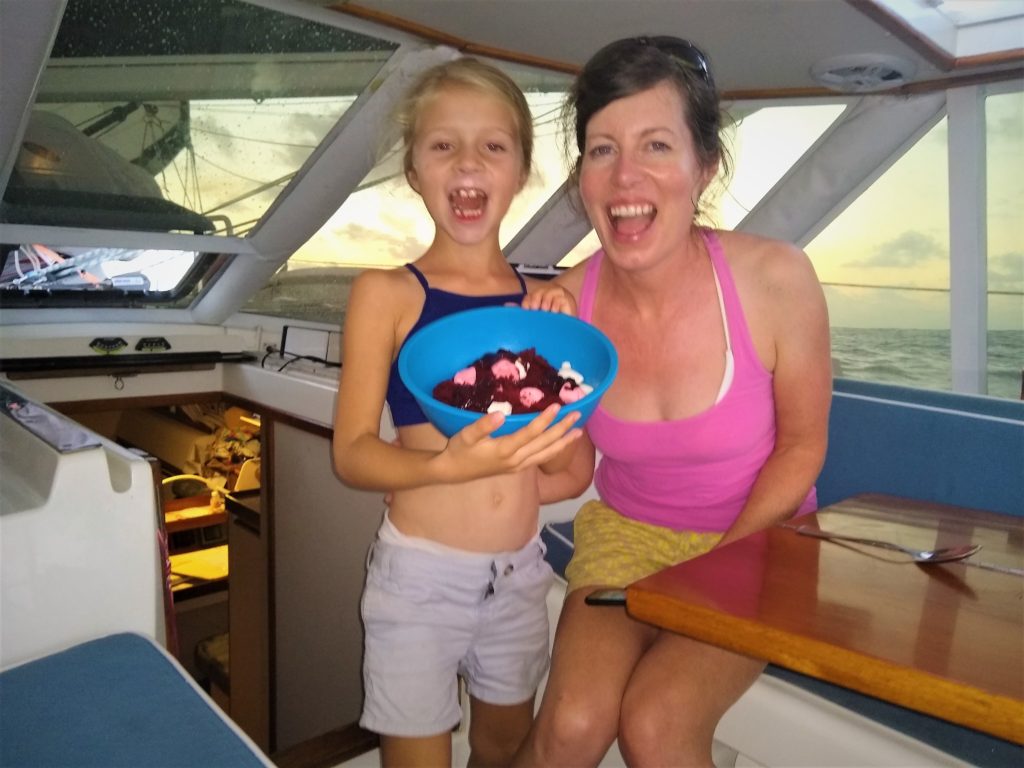
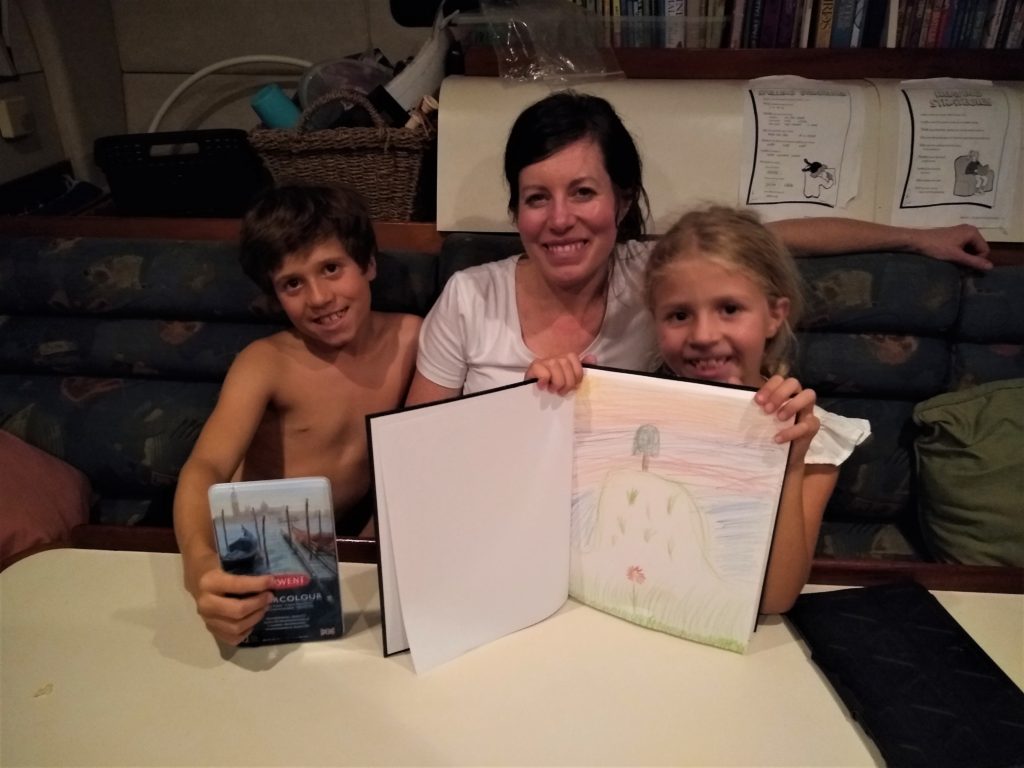
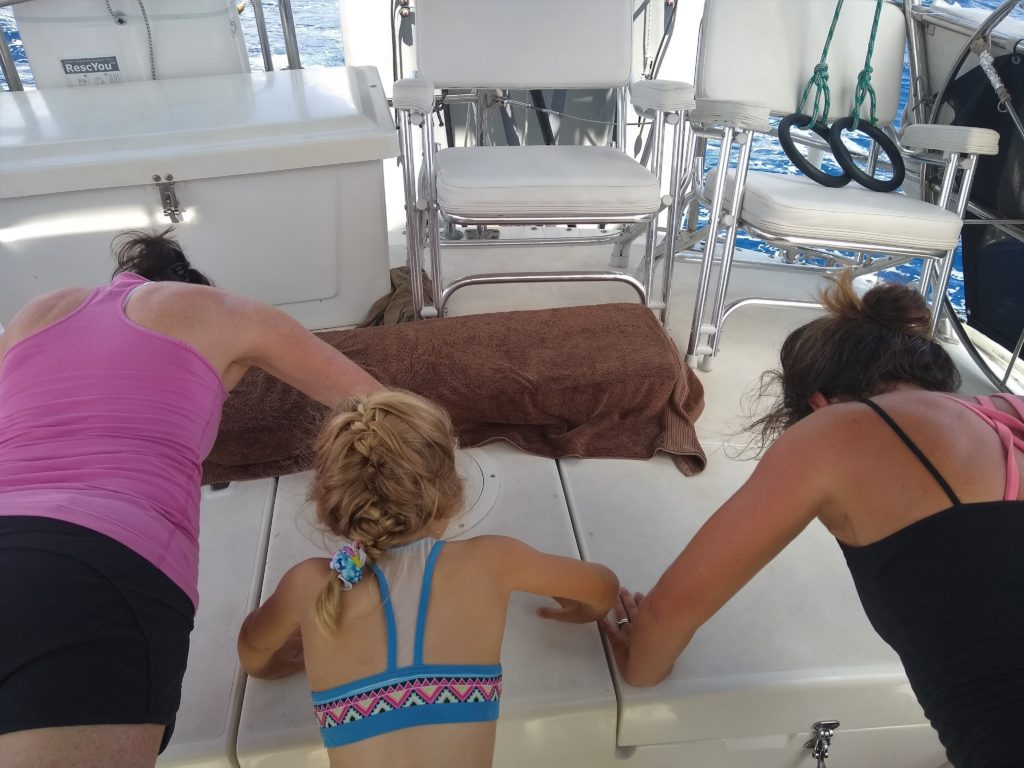
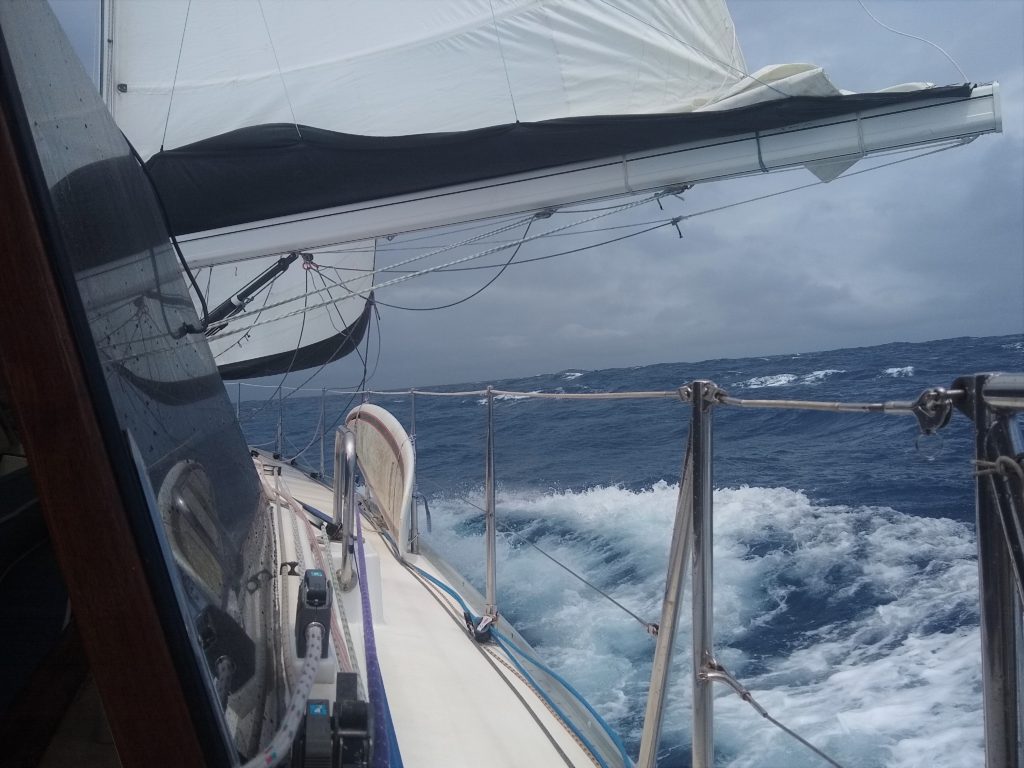
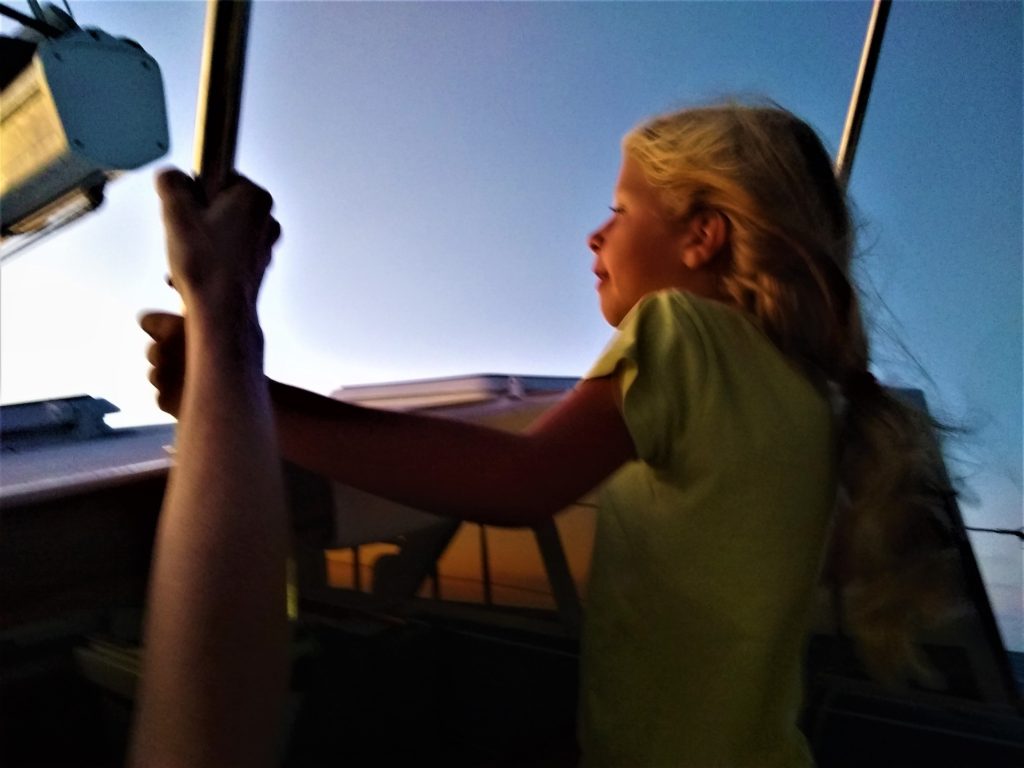
We are thrilled to have made safe passage from Barra de Navidad, Mexico to Hiva Oa, Marquesas, French Polynesia. It was an amazing couple of weeks! Here is an overview.
Distance (crow flies): 2900 nautical miles
Days: 16.0 (not counting days at anchor at Revillagigedo Islands)
Top Speed: 14.8 kts
Highest Wind speed: 44 kts
Total motoring time: 7 hours
Best Meals: Gill’s vegan bowl/Vietnamese Salad Rolls/Rice bowls/Cinnamon Buns/Prawn Curry Pasta/
Best 24 hour mileage: 204 miles
Fish: 2 blue striped Marlin, 2 yellow fin tuna (released 2 marlin, plus giant tuna)
Broken Gear: Asymmetrical spinnaker (torn clew box); spin halyard chafed through (1x); sea strainer (replaced), forward bilge pump hose (cracked), fridge hose (replaced). Kudos to Gavin for this list being so short. A+ for boat prep.
Wildlife: LOTS of dolphins and birds, giant manta rays, silky sharks, flying and regular fish, squid
Funniest moment: (a tie between Gill rocketing out of the water after glimpsing the sharks, and Gill continuously getting mixed up with sailing terms – “Are we going to ‘heave ho’ (instead of heave to)? and “Do you think we will pitchfork (instead of pitch-poling)”? This would generate fits of giggles and guffawas by the rest of us on board. And no, we never came close to pitch-poling!
Lowpoints: worries about 2 medical issues, but thankfully all turned out fine. Huge thanks to Dr. Suzanne! More info later in post.
Highlights:
- Auntie Gill’s daily Pacific Crossing Advent for the kids: they each received a new treat each day…food, a book, a toy…Wow! Lucky kids and Thank you so much Gill!
- Reading aloud in the Cockpit – Swiss Family Robinson, The Skeleton Tree, Montessier and more
- Nighttime stars, bio luminescence and warm breeze
- Daily cockpit bootcamp/yoga on the back deck: we alternated strength training and yoga days to keep our bodies limber
- Homeschool with Auntie Gill: Thank you Gill for being Julia’s favourite teacher ever!
- Baking with Gill: mmm Cinnamon Buns were so good
- Reeling in giant fish in the middle of the Pacific – WOW
- Watch the growing confidence in the kids… “We’re shellbacks now” says Nathan’ proudly, and Julia, “Mom, now I’ve sailed in 44 knots and crossed the Pacific!”
- Seeing land for the first time and finally arriving in Hiva Oa – we made it!!!!
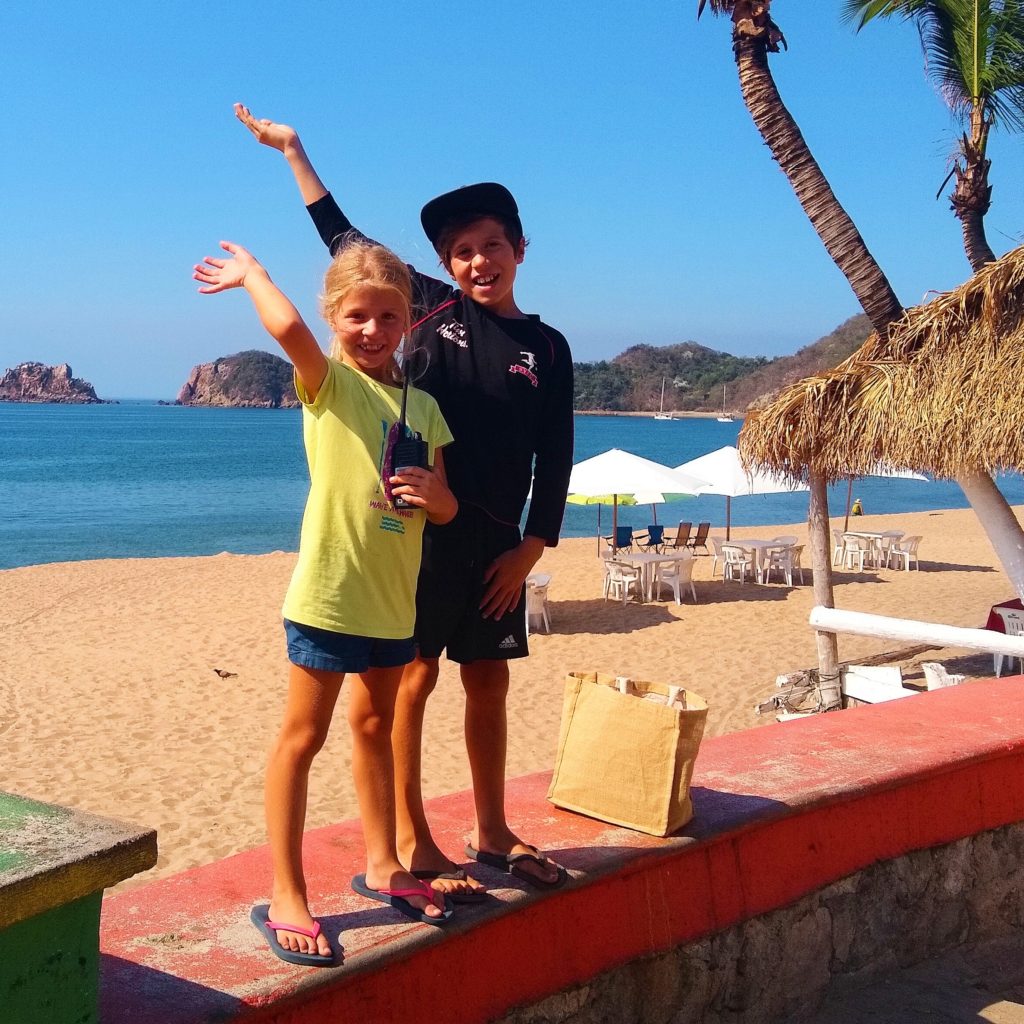
Leg 1: Mexico to Revillagigedo Islands. Here we go….the big one!
It was surreal to be on the cusp of another long sailing passage. This was ‘the big one’. In our Vancouver life preparing for our trip, the ‘big passages’ we thought about were (1) Van/San Francisco; (2) Mexico to Marquesas; then (3)Tonga/Fiji to New Zealand. Well, the big one was finally here!
We weighed anchor from Malaque at midday and were excited to be setting off into fresh breeze and sunny skies. We left the anchorage with mixed feelings, reflecting on the previous few months. We enjoyed our time in Mexico – friends we were leaving behind, friendly Mexican people, beautiful cruising grounds, and lifetime family memories – and recognized that this chapter had come to an end. We waved goodbye and focused on the horizon.
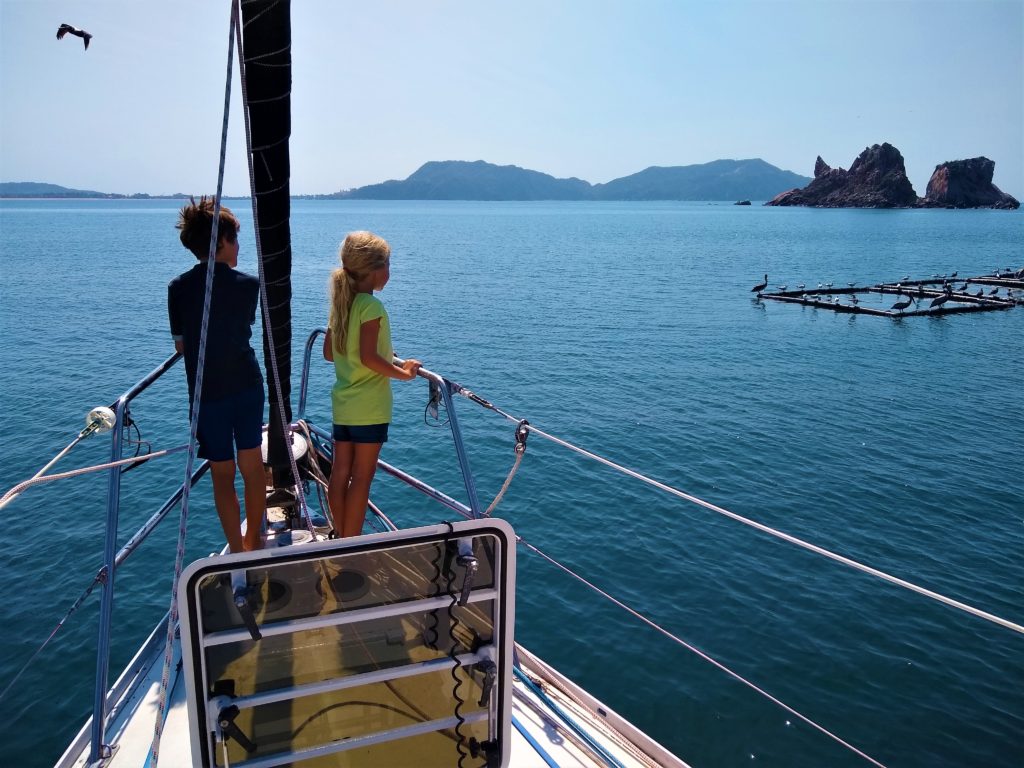
Perfect first evening send off
We started with close hauled sailing (beating) into 15 to 20 knots to make it to Isla Benedicto, our first stop in the Revillagigedo Islands. Our first sunset at sea was one to remember. A large pod of spinner dolphins swam with us for over twenty minutes, playing in our bow wave and flipping and spinning with amazing acrobatics right beside the boat as we literally sailed into the sunset. It was the perfect way to start the passage and was a hint of several memorable interactions with wildlife we would have over the coming days.
The boat was remarkably comfortable beating upwind. Healed over to 15 degrees with our water ballast pumped into the windward side kept the boat stable and we made great pace to the islands. Gill cooked her first dinner in the galley, a delicious vegan bowl from a restaurant in Vancouver, while underway and it was a delicious success. “This wasn’t too hard,” she said. Well, it would get a bit more challenging!
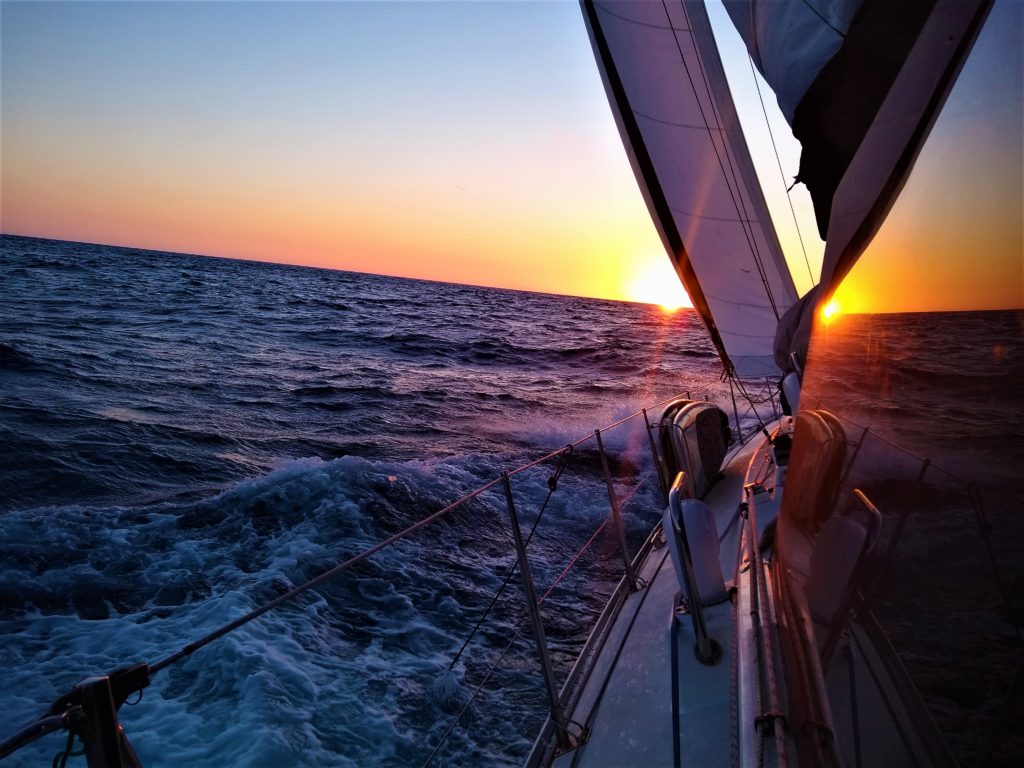
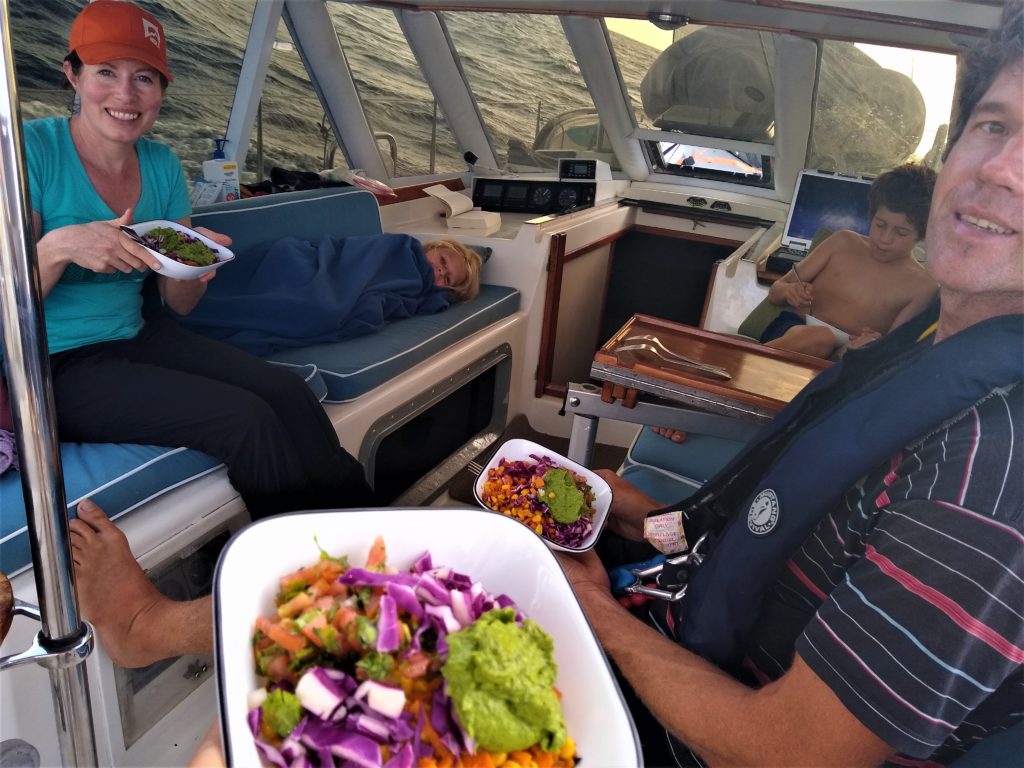
Wonders of Isla San Benedicto – What’s that in the water?
We motored to Isla San Benedicto with the early morning sunlight capturing its striking landscape. It looks like a moonscape rising right out of the ocean. A recent (in geology terms) active volcano with grey and black rocks jutting upwards in geometric patterns, with large ocean swell crashing against cliff walls and a small black sand beach. A truly special place. We carefully anchored in 50 feet of water, tying a bouey to our anchor (these islands are known as ‘anchor eaters’ with their rocky bottoms and a line tied directly to the anchor can help to retrieve the anchor if needed – thankfully not issues for us with the anchor this time).
Within seconds of dropping the anchor, we could see numerous large fish swimming next to the boat in clear and beautiful deep blue water. Dolphins swished and frolicked yards away from the boat. Nathan scampered down to the swim grid, and hung his head over the side with his mask on peering into the water below. “Mom, there are so many fish down here…. the water is so warm…. Hey, I see a shark!! Come! Look over here!”
Gill was the next one to grab her mask and climb down the ladder. A water lover, usually Gill dives right into in with no hesitation. We’d told her not to dive in as this can ‘attract sharks’. She has a lot of experience snorkeling and past experience swimming with reef sharks. “No problem” she said. This time, Gill decided to follow Nathan’s lead and peer into the water head first without first putting her whole body in. This was followed by a yelp “Wow, that is a huge shark, it is right there!” and she jumped out of the water “I’ll go snorkeling later” she said. We all agreed!
All of us took turns putting our heads over the side with our masks on, peering in wonder at the large schools of fish that had arrived out of nowhere huddling under our boat, with a couple of 6 foot silky sharks swimming nearby. Then someone put our green foodscraps over the side and there was a feeding frenzy of fish and sharks right off the boat. Shark fins were darting back and forth. I guess we will try snorkeling off the boat later!
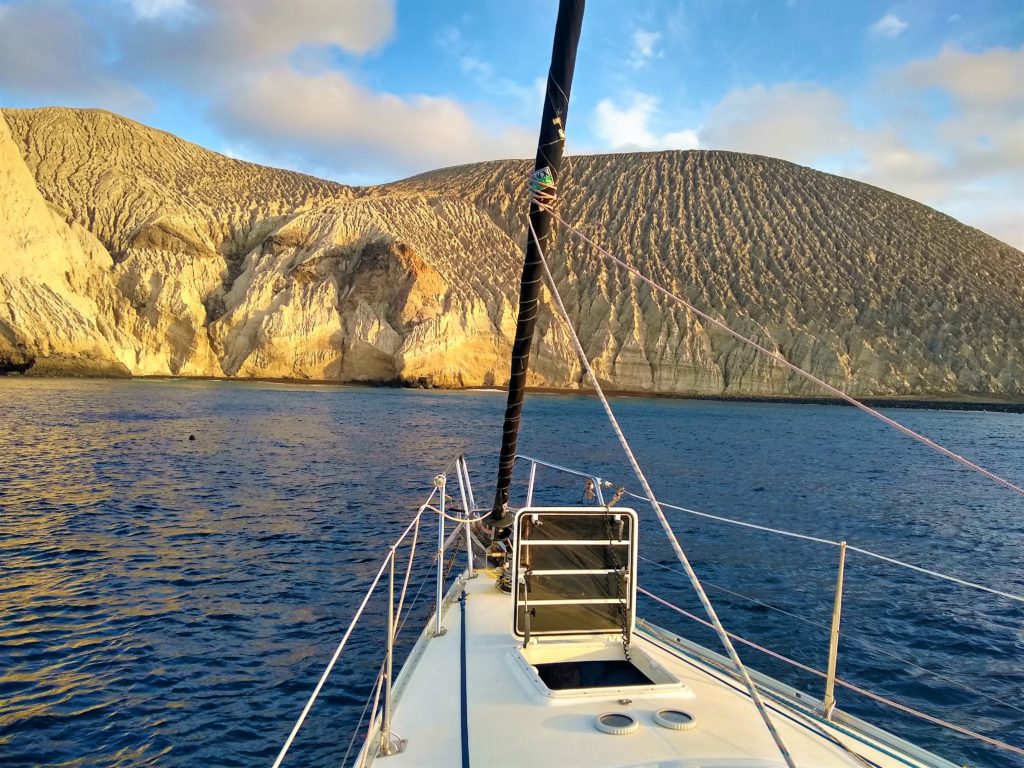
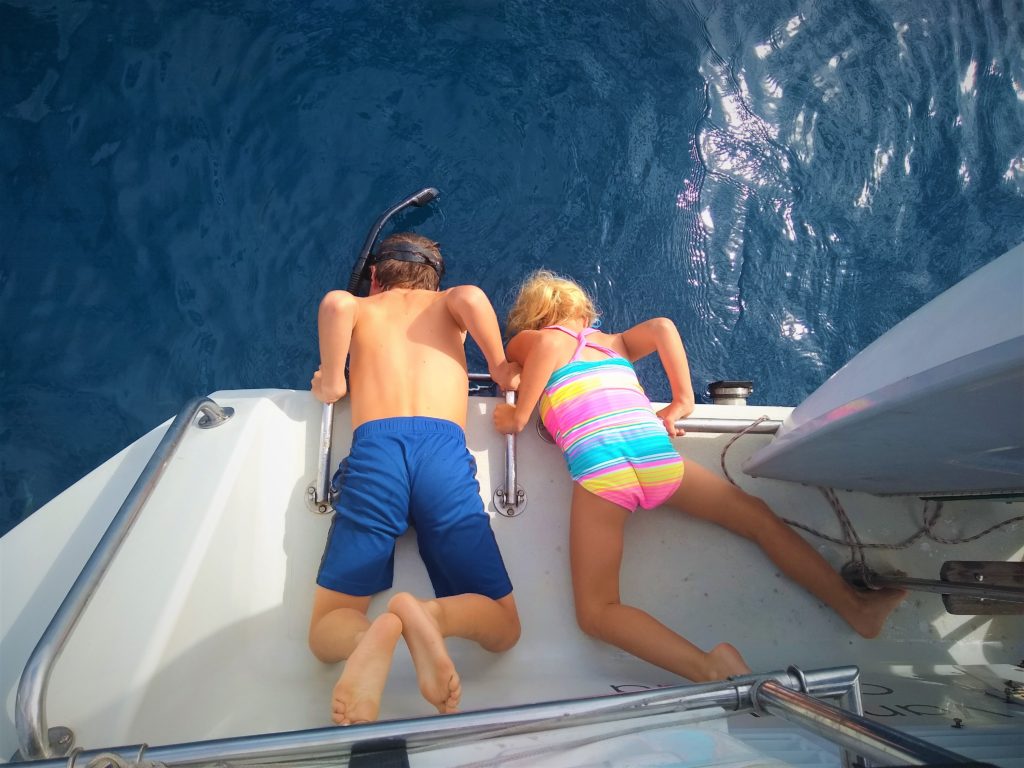
We put the dingy in the water an decided to try snorkeling farther away from the boat (sharks) at some locations we’d been told about by others who had recommended we stop at these islands (thank you SV Liahona!) These islands are considered one of the top diving destinations in the world and are a protected national park, with strict fishing limits well offshore of the islands. Known for large schools of pelagic fish, giant manta rays, and a species of angel fish only being seen at these islands, we were keen to test the waters. While we are not divers (yet) we love snorkeling and were assured there would be lots to see. Friends had told us that the silky sharks were friendly and not to worry. My fish book put silky sharks in the ‘aggressive’ category. Hmmmm, who to believe?
After a breakfast of homemade Cinnamon buns baked by Gill and Nathan, we took our dingy to some nearby cliffs and shallow water closer to the beach. We were treated to coral, a white tipped shark, schools of fish and saw the angel fish unique to the island group. Later that evening we were enjoying a sun downer on the bow when a dive boat dropped off a bunch of clients to dive at a popular site, the pinnacle, that was 20 meters from our stern.
Mantas at the ‘boiler’
I asked the dive boat about the Mana Rays at the ‘boiler’ – a known site on the windward side of the island where manta rays are known to congregate. He assured me that the manta rays were there. It was a calm beautiful evening with a couple of hours before sunset and the wind was forecast to increase the next day which would have made a dinghy trip (the 2 miles) around the island treacherous. We grabbed our gear and hopped into the dinghy.
Even in ‘calm’ conditions, the swell was considerable as we rounded the corner and Gill’s eyes widened as we zipped over the large waves. Even Gavin had to ease off the throttle. We were treated to beautiful views of the West side of the island as we motored closer to the spot we thought was the boiler.
Friends had told us that you want to be sure that you trust your dinghy if you make a trip to the boiler. If something happens, there is just wide open Pacific to drift to. I was happy to see a few other dive boats up ahead for this reason. Nice not to be alone at this spot!
We jumped in where the water literally looked like it was at the beginning stages of a rolling boil with large pockets of water slowly being pushed upwards to the surface (this is due to rock formations underneath which cause the water to look like it is boiling) and were amazed to see giant manta rays swimming back and forth interspersed with divers from nearby diving boats who had traveled great distance for this very experience. We felt so lucky to be able to show up in our dinghy and see these magnificent creatures. The mantas looked huge compared to the divers deep below us. Not encumbered by heavy dive gear, Gavin was able to freedive and swim right alongside one Manta for a long stretch. Their fluid movements and striking white and black markings were a sight to remember.
The next morning we arose early for another snorkel – this time near the boat. We implemented a ‘no food scrap rule’ prior to snorkeling. We were treated to dolphins frolicking around us and the boat, and schools of large fish. Then Nathan shouted, “Manta!!” and he took off like a rocket, snorkeling above a Manta. We all joined him and followed it for some distance. Wow, who knew we didn’t need to go to the boiler to see the Mantas? We loved Isla San Benedicto!
That afternoon we sailed downwind to Isla Socorro anchoring off of Cabo Pearce. Again, within minutes of putting our anchor down, five large sharks came to say hello. We enjoyed the scenery of cliffs and landscape, but elected not to snorkel!
The wind blew all night long and our anchor rode had wrapped around a rock formation which made for a loud sleepless night. The next morning we were tired and decided we would make use of the good wind and set off for the Marquesas. After the noisy night of listening to our chain, I was worried that it was good and stuck and I was worried about losing it in 60 feet of water. Luckily, after a few back and forth movements, it came up.
If you plan on visiting – Note about Park Permit for Revilligigedo Islands: we obtained an annual pass to visit these islands via email from the park officials in Mexico. Thank you to SV Flocerfida who kindly let us review their spanish letter. We made some adjustments and sent it off. Then we paid a fee at the bank (about 1500 pesos). We never saw any of the army folks during our brief stay. They are based mainly in one bay in Isla Socorro which we never visited.

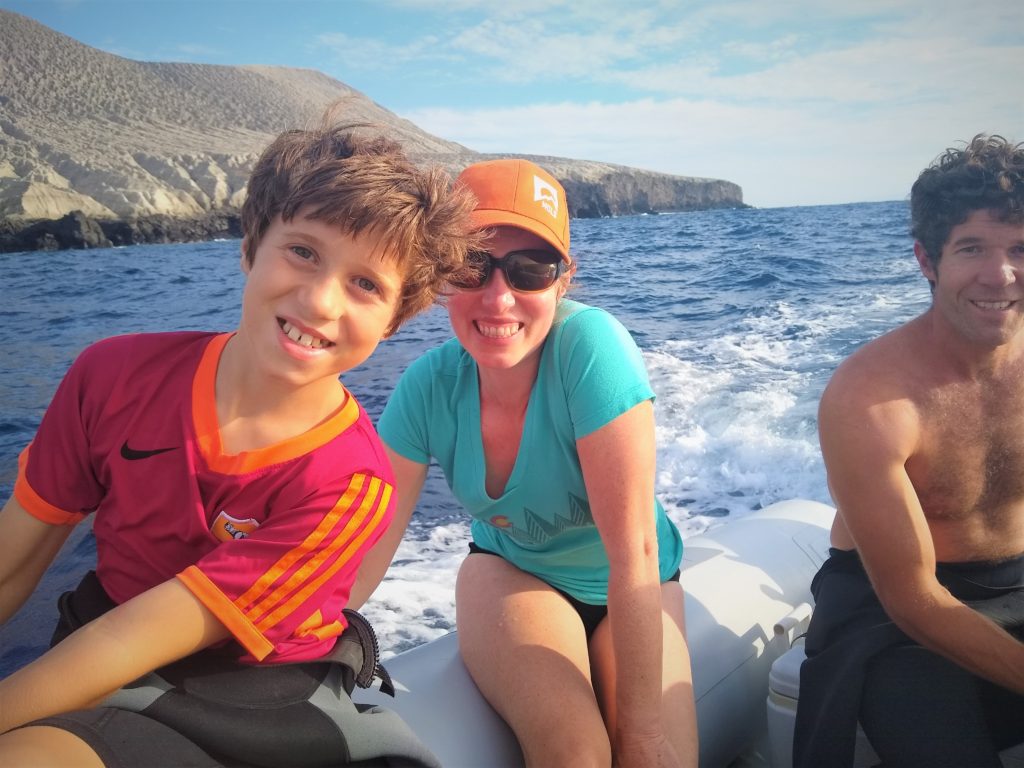
Leg 2: Revillagigedo Islands to Hiva Oa
The next fourteen and a half days were filled with glorious sailing amid the rushing sound of water zooming by us, moon and starlit skies and some exciting events along the way.
In general we were blessed with good winds for most of our passage, only motor sailing a short 4 hour stretch near the equator. Slingshot sailed beautifully, with many evenings and days of us blasting along between 8 to 12 knots on a stable platform despite the ocean swell ranging from 6 -12 feet. We sailed at about 90 degrees apparent wind for most of the passage which helped keep the boat stable and sailing nicely through the swell.
Gill said, “Wow, this is pretty smooth, I thought there would be more work to do to sail the boat!” Of course there were moments of work, especially navigating through squalls, and some times with all hands required on deck. But mostly, the boat sailed herself. We didn’t even have the steering wheel on most of the passage (steering with our autopilot 24/7 we kept it secured nearby which allowed for more room to do yoga and exercise in the cockpit :).
A testament to the balance of the boat under sail was highlighted on the first evening of our passage. Gill and I thought we were sailing well and adjusting the autopilot minimally, clicking up and down hear and there, when Gavin came out and asked, “Who turned the auto pilot off?” Oops. Gill and I had been sailing upwind in 15 to 20 knots of breeze with the autopilot off for over half an hour and didn’t even realize it!
Watch Schedule:
Our overnight watch schedule was:
Gavin 9-12
Jenn 12-3
Gill 3-6
This worked out very well and we all felt reasonably rested with a combined 6 hours of sleep each plus another couple of hours during the day or evening. Thank you Gill! This extra sleep was so appreciated! We alternated through the same rotation of loose shifts during the day. The kids were on the ‘watch list’ with one of us also being on watch at the same time. Nathan was a huge help, steering during gybes and helping with the lines and tailing the winches.
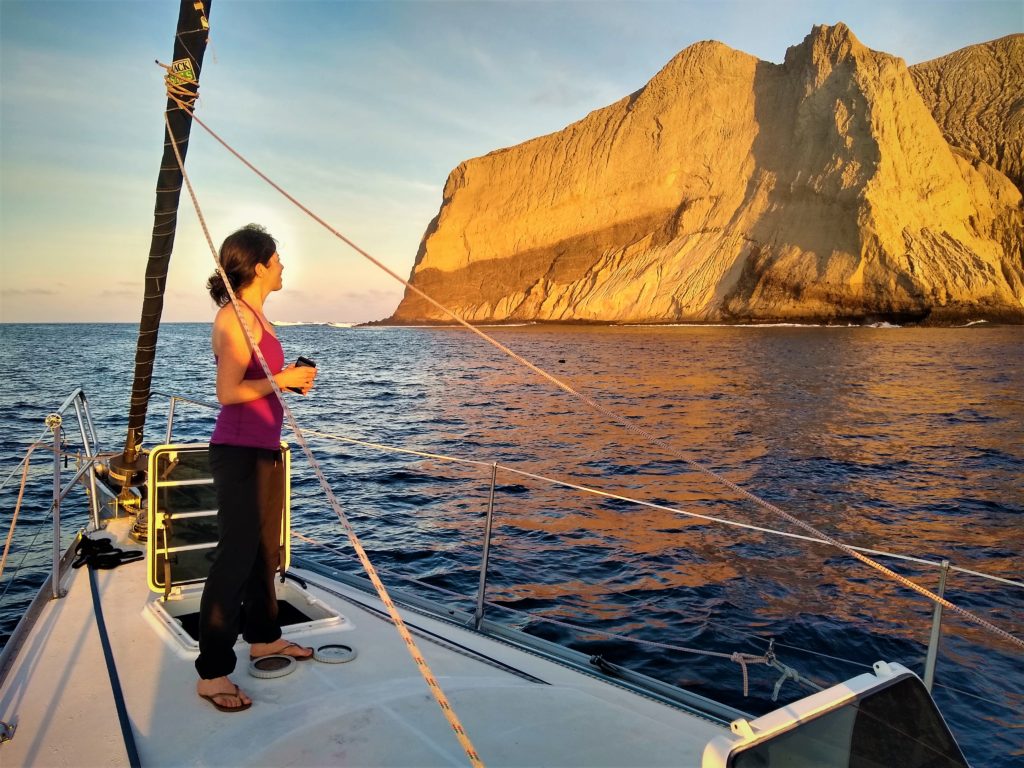
Mechanical Issues – Gavin, why is there water in the bilge?
On day two from Isla Socorro, we had a bit of scare. Gavin looked in the engine compartment and we saw water sloshing around below the stringers. It was not a great deal of water, but still. We were over 700 miles from the mainland and water ingress is never a good thing. Gavin easily sucked the water out, and we searched for the point of entry. Hmmmm. “I think it’s from the rudder packing”, said Gavin.
With the boat heavily laden with fuel and our water tanks fuller than usual, plus the huge payload of food aboard, we were lower in the water. Gavin had replaced the rudder packing with fresh packing prior to leaving Barra de Navidad, and we thought we saw a small trickle of water in this area. Gavin tightened things up and we shut the hatch.
A few hours later we checked under the engine room hatch – yikes…more water. This time, I tasted it. “It’s salty.” This helped narrow down the source. If it were fresh it would be a matter of checking the water maker and fresh water plumbing. Frankly, the taste of salt water did not make me feel better. Leaking from the sea into the boat is a much more serious problem. Gavin continued to search and then I heard, “I found the leak.” Thank goodness! “It’s the salt water strainer for the engine, the seal is leaking. I’ve got a spare right here.” Another thank goodness! Half an hour later, Gavin had replaced the sea strainer with a new one we had on board and the water leak had stopped. We still checked the bilge every day to ensure there was no water. And there wasn’t.
There is something about being so far out there and away from any timely help, should the need arise, that makes the mind do funny things. Helicoptor rescue won’t help when you are 200 miles offshore and here we were, most of our journey was well outside this range! I found myself having to control those thoughts of ‘what if’ and put them to the back of my mind. It’s part of what makes sailing across a large stretch of water feel so much different than a passage nearby land.
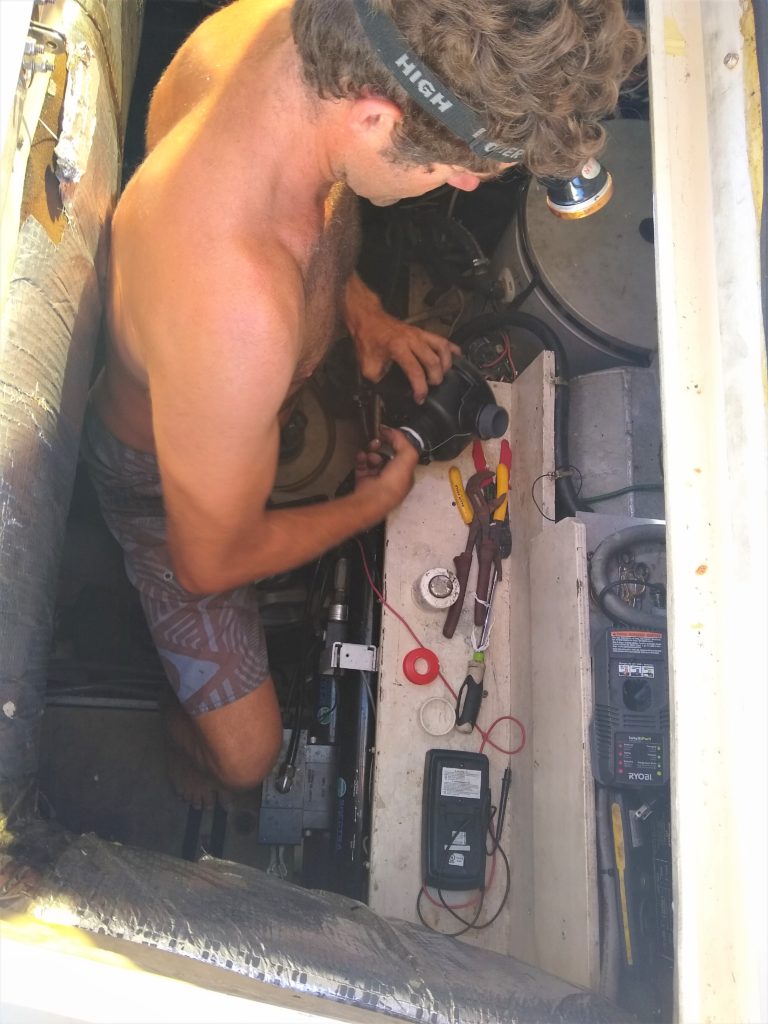
Mom, why isn’t our spinnaker up anymore?
A few days into our passage we blew the clew out of our spinnaker. We had just watched the knot meter rise to 28 knots during a gust and were talking about whether or not we should take the spinnaker down and poof, the spinnaker blew.
I had a bad sinking feeling and felt sad. It was early into our passage and we had been using almost exclusively our A3 reaching spinnaker and enjoying stability and good speed. The boat was much less stable without the spinnaker up, and our speed dropped off considerably.
The rip was large. True to his nature, Gavin wasn’t phased. “Jenn, Spinnakers rip. We will hand sew it if we have to. It might take all day but we will figure this out.” I appreciated his positivity but I was skeptical about the sewing option. It was a huge rip. And I hate sewing.
We had a slow rolly night and when Nathan woke up, he immediately wanted to know where the spinaker was and why we were going so slow.
We pulled out our Code Zero and put it up at first daylight. Our spirits picked up along with our speed when we found the angle we were sailing to our destination would suit our code zero just fine and wasn’t too bad after all! While it has less sail area and we didn’t reach as high average speeds, it was easier to control, built with a much stronger fabric and we kept it up for the rest of the passage. Code Zero, we love you!
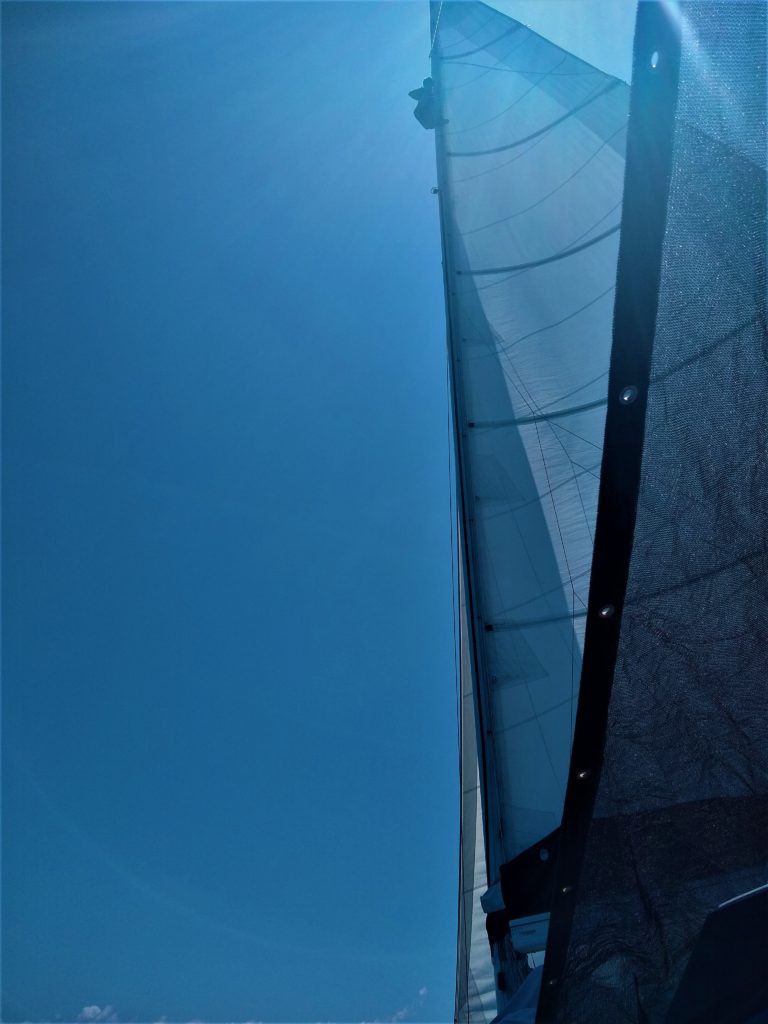
Hey, shouldn’t we check the chafing situation on the halyard?
Lesson learned. I won’t say who was involved but there was discussion about the halyard chaffing on the code zero and whether we should take it down to check. “No need, it is fine” was the conclusion.
A couple of hours later, there was a ‘pop’ and we watched the sail drop softly into the water. Thankfully it was daylight. We headed into the wind, pulled the sail on deck and assessed the situation. Good news, there was no rip in the sail, it was just the halyard having chaffed through after more than 24 hours of continuous use. This is somewhat common in offshore continuous 24 hour sailing, especially when there is good breeze and high loads on the sails and gear. Bad news was that it cost us another slower night with more motion and we had to send someone up the mast! The swell was considerable – over 8 feet – and we did not want anyone going up the mast in those conditions. We waited until the next day when the seas were flattened out and Gavin went up the mast. I was very happy when we landed back on the deck safely.
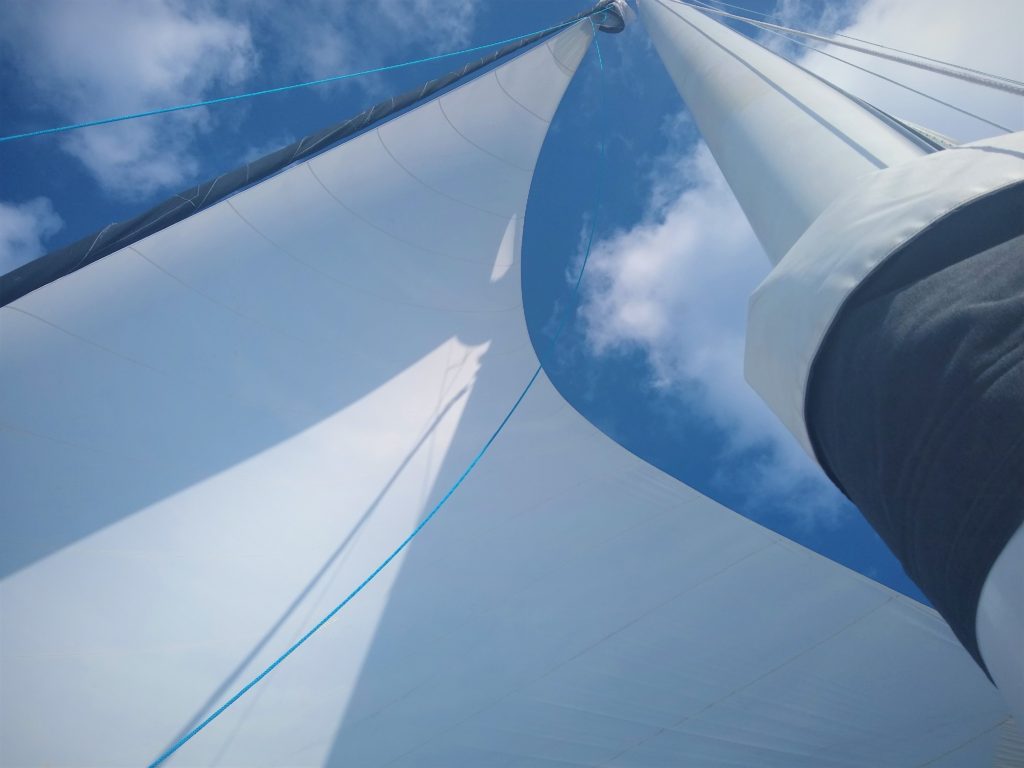
What did you do all day? Weren’t you bored out of your mind?
Yes, crossing oceans gets monotonous at times. Yes, we all wanted to get there ‘faster’, especially after crossing the equator. And we were all missing stretching our legs and going for walks. It was strange to see nothing but blue ocean day after day and it did feel like that movie Groundhog day, every day waking up to the same scene! Thankfully the days passed by quickly and there seemed to be a lot to keep us occupied. Meal prep, homeschool, Gill’s daily advent calendar, reading aloud in the cockpit, daily workout/yoga, movies in the afternoon/evening after school, satellite and single side band checkins with other boats – were all activities that took up the day. Before we left I wondered how hard it would be to be on the boat 24/7. It was probably the helpful and fun addition of Auntie Gill but it wasn’t too hard at all. Also I think we were lucky with good solid wind for the most part which kept the boat comfortable and people’s spirits up.
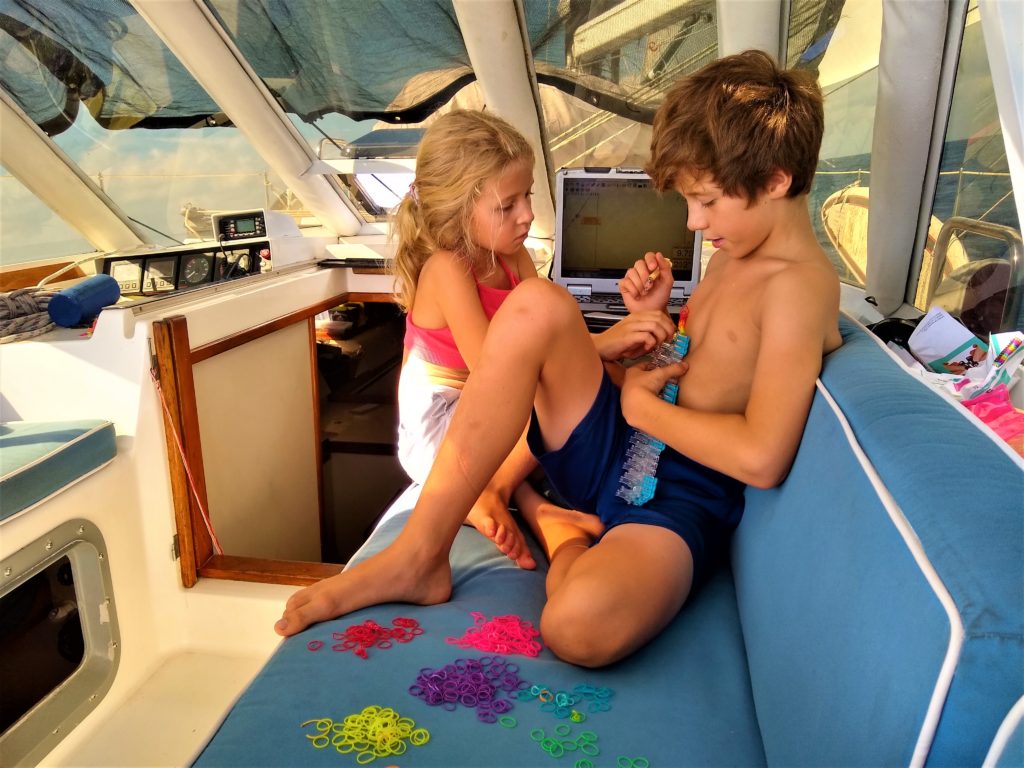
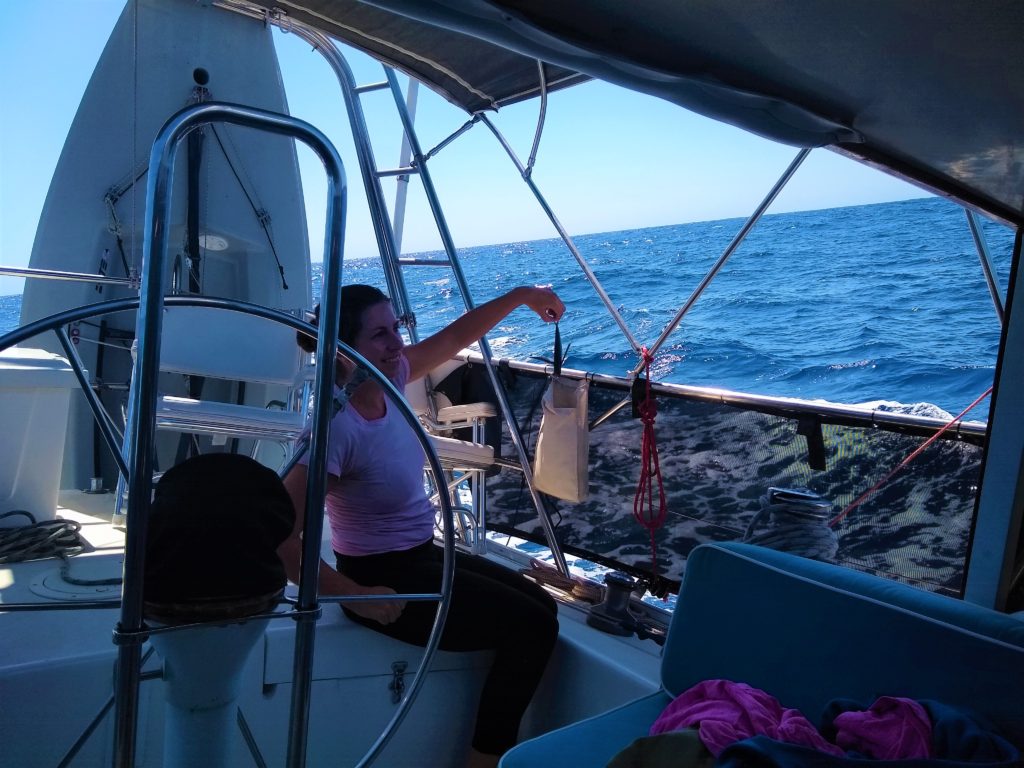
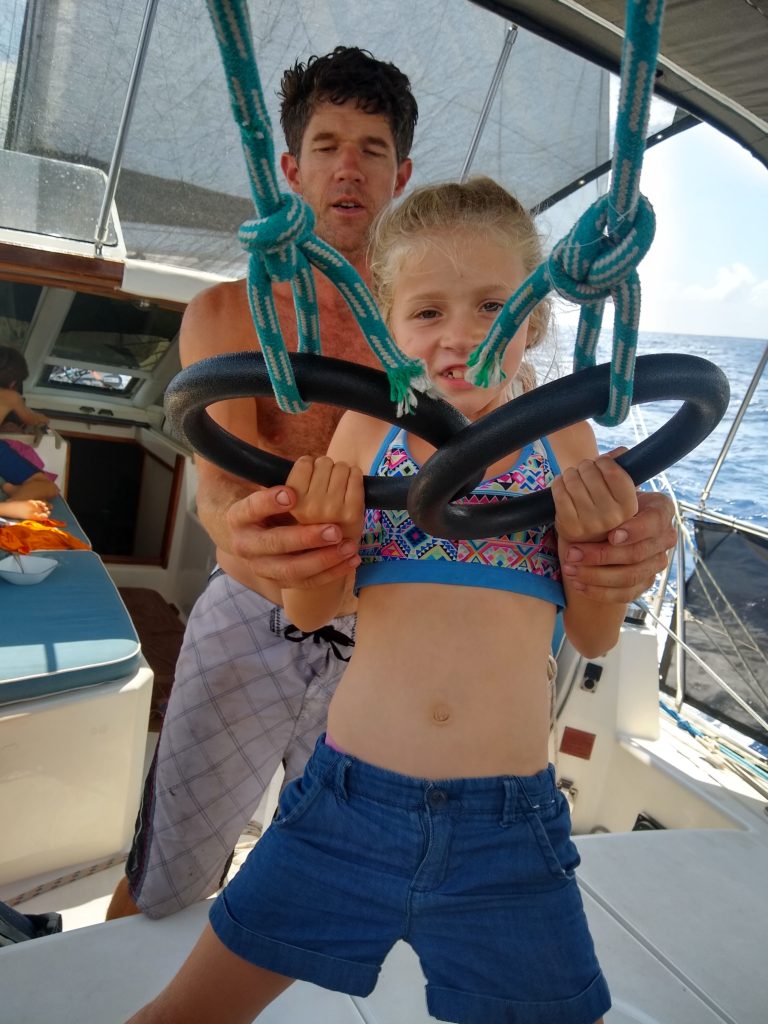
Hey Gavin, wake up, can you have a look at this squall?
This was our first experience in navigating squalls in the ITCZ (short for intertropical convergence zone). They are easier to see at daylight – large anvil shaped clouds with dark grey underneath. But of course, they tend to become more active during the evening with the cooling of the air and condensing of the clouds. Our radar was a key tool to help us spot the squalls, appearing as large red blobs that moved across the screen.
We pulled out our trusty Steve and Linda Dashew weather book to refresh ourselves on squall behaviour and what to do. Basically, we would figure out which direction the squall was going relative to ourselves and try to avoid placing ourselves on the leading edge where most of the wind is. This would involve gybing, heading up or bearing away. Sometimes we got caught in them. Then we would reef and furl and ride it out. None of them were too bad. But it’s hard to tell what wind they will carry with them, and we were fearful of ripping more sails in the strong winds that can accompany the squalls.
More than once I woke up Gavin during night shift as red blobs neared us. One night, I waited a bit too late and we had rain, wind and a lot of sail maneuvers to put ourselves into the best position to mitigate the squall. “Jenn, you sailed us right into the middle of that one!” muttered a tired Gavin. This involved, Gavin getting wet doing foredeck work (furl the code zero, reef the main) while Gill and I did pit and rushed around closing hatches. To make things more fun, squalls often arrive in clusters, which means that just because you’ve successfully avoided one, it may put you right in line to get hit with the one following, which is probably stronger. Fun times! Overall, My lesson learned, do not try to outrun a squall if you are on a similar angle to it!!!
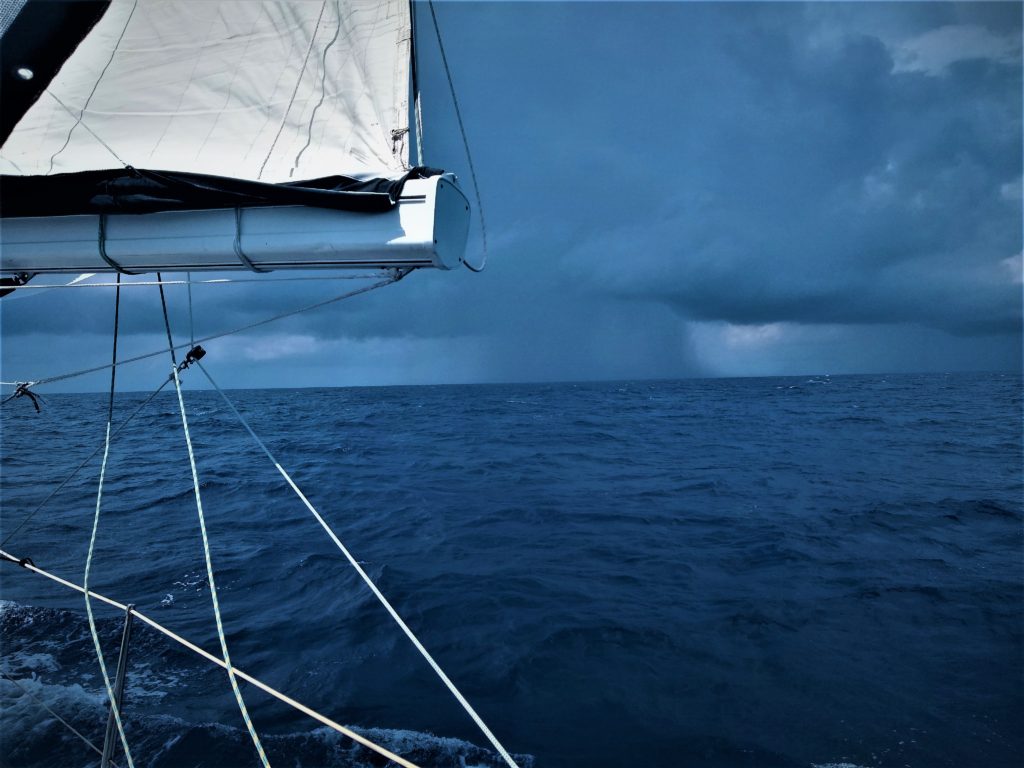
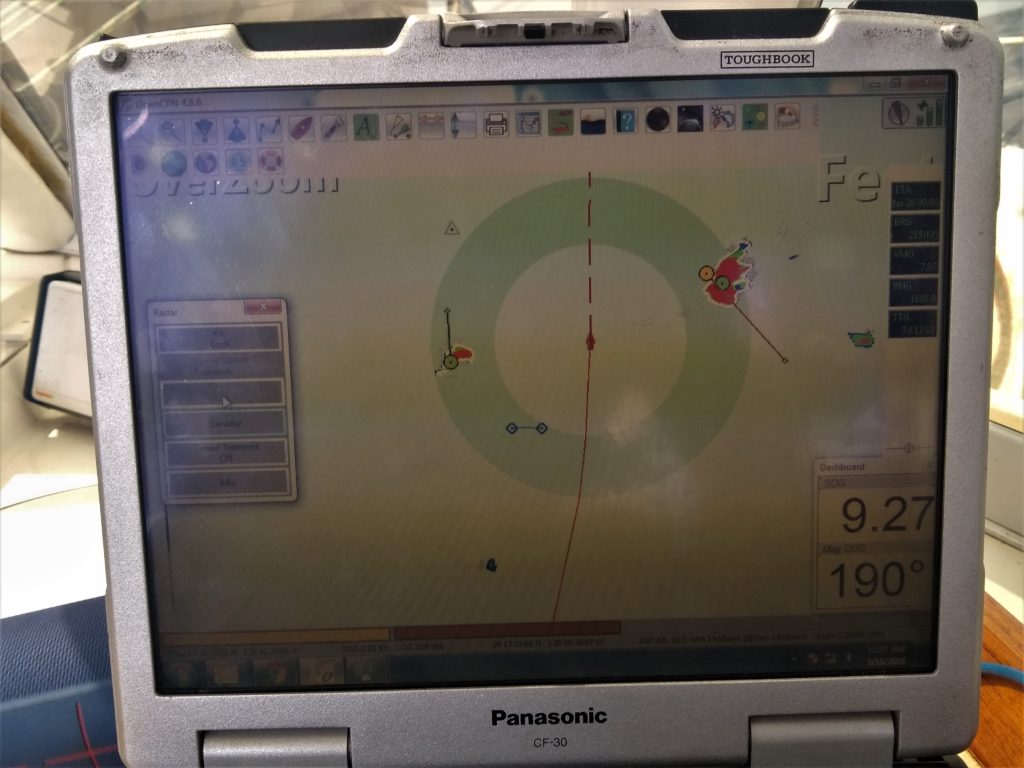
Equator Crossing – “Mommy, I’m a Shellback now!”
One of the big events of a Pacific Crossing is the crossing of the equator. Those who have not crossed the equator by boat are called Pollywogs, and those who have crossed the equator graduate to shellbacks. We crossed the equator during the late evening and celebrated with pictures of the 000’s on the chartplotter. The next morning we had a delicious breakfast of crepes made by the kids. Also we had purchased green coconuts in the husk while in Mexico for the occasion and broke out some Tropicana rum and pineapple juice. The kids made King Neptune costumes and we wrote a poem together that Nathan read. It was a memorable experience and I loved Julia’s proud announcement that, “We were all shellbacks now!”
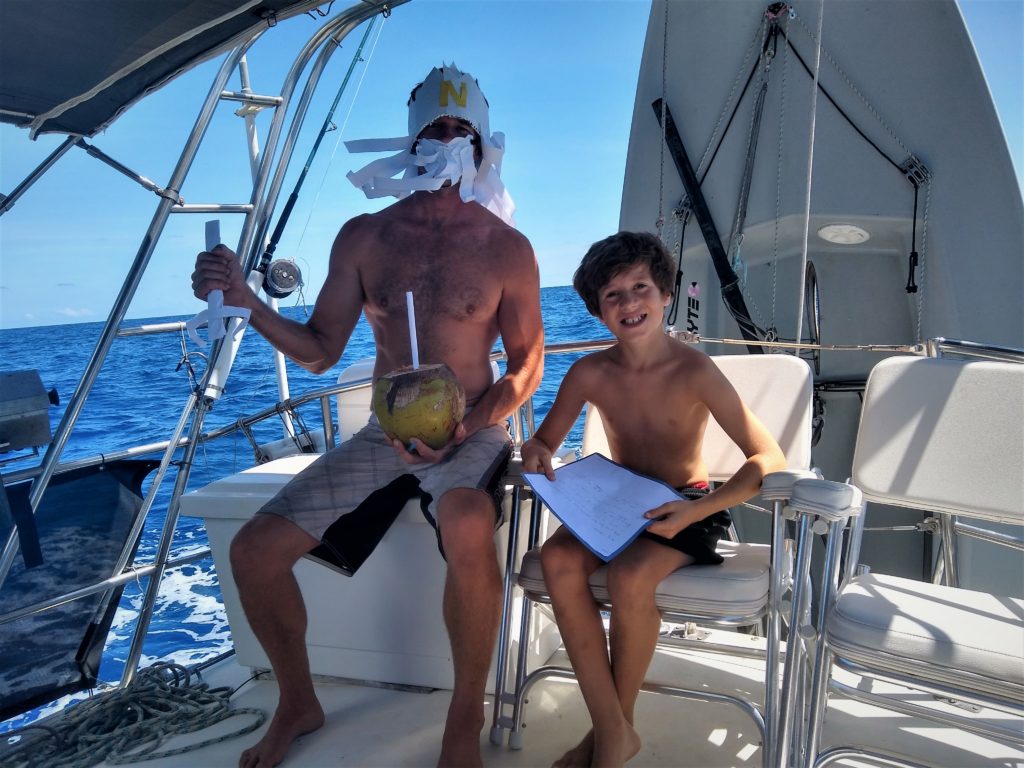
Medical questions
One of my biggest fears about crossing oceans is having a medical emergency at sea. It is one of the risks that comes along with this adventure. Some people take things to the extreme and actually have their appendix removed prior to ocean crossing. Rare but true! Everyone seems to prepare their medical kit and themselves (with courses etc) as much as possible to make it through anything that comes up.
We have the benefit of a friend who is a physician (thank you Suzanne!) who patiently helped and coached us through stocking our medical kit and coming up with supplies for ‘what if situations’. She was also kindly available for consulting via our sat device when a couple of medical questions came up.
One was a small cut on a hand that was not healing in the tropical environment and we confirmed which medicated cream to use. The other was a virus that Julia picked up which we were worried about, but thankfully Julia improved and was on the mend. We actually think she may have had dengue fever which she picked up in Barra de Navidad before leaving. While most sufferers will have mild flu like symptoms and recover quickly, there are rare complications than can be very serious and life threatening. When Julia’s gums got puffy and red, I worried that this was not a regular virus. Thankfully, other than a couple days of fever, she has recovered and feels fine.
Land Ho!!
It was exciting to see Hiva Oa emerge out of the sea mist. We were all amazed by the mountainous views as we motor sailed the final miles. We anchored nearby Atuona and enjoyed a champagne toast with some delicious bubbly we’d purchased in Napa. Too soon we had to say goodbye to Auntie Gill and we were all sad when she left. It felt like she had become part of the crew and we wanted to keep adventuring with her!
Where to next? We are exploring the beautiful Marquesan Islands before setting sail for the Tuamotu atolls. We will try do another post highlighting the amazing experiences we’ve had in the Marquesas. However it may be a bit delayed until we get solid internet in Papeete – about 6 weeks away!
Note about Internet in French Polynesia: we are using our Google Fi phone package which gives us “E” connection. It is very slow and even a simple google search will time out. We bought a sim card (400mb for about 5 euros) but haven’t used it yet. We met another cruiser who used it and then said she received texts for a $50 bill afterwards? Strangely Instagram loads (slowly) but at least seems to work which I have automatically linked to Facebook. Interesting how well instagram and facebook work here when nothing else seems too….those IT development folks are smart (of course)! We need to wait until we can get to a cafe or library for a ‘real’ connection to do anything more substantial like upload a blog post etc. And even then I’ve discovered it is slooow, especially to load photos. So our blog posts might be a bit intermittent for now but I will continue to post to Instagram when we have signal. For those of you with good internet enjoy! It is a luxury!
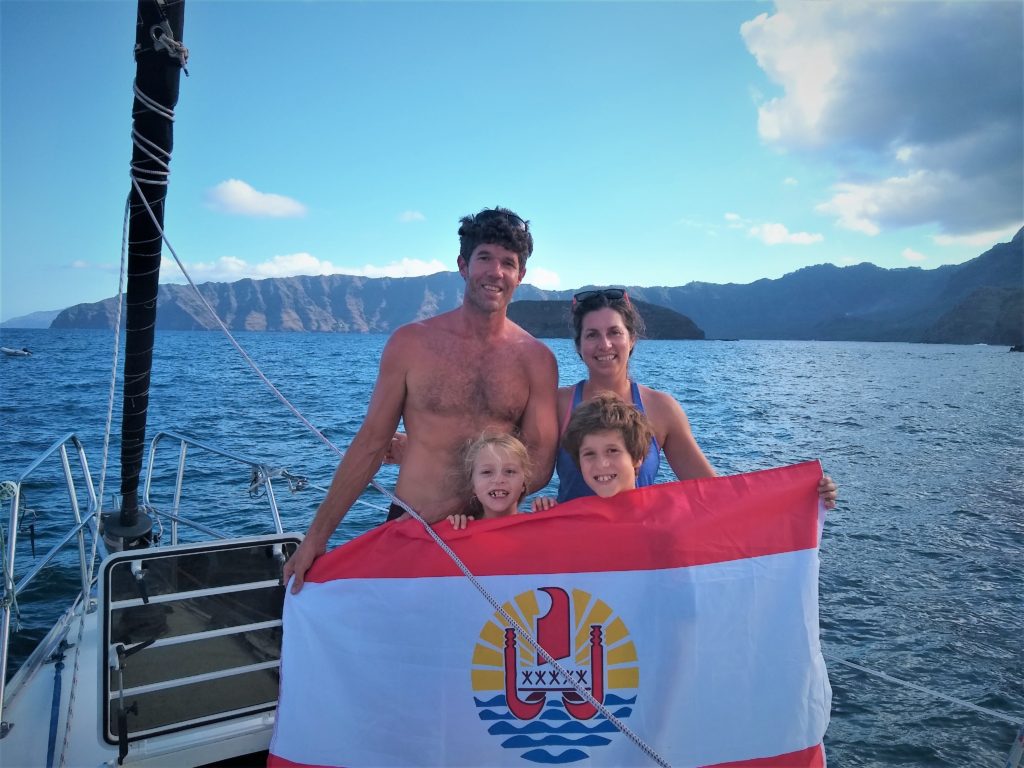

I have tried sending you e mails but it always tells me here that it is an illegal domain name, is it just me or are others having the same problem.
Congratulations on a great trip and a wonderful experience for the kids.
Worried when I first saw you stopped on the wind chart but then realized I had to blow it up to see the Islands.
Keep safe and enjoy.
Love Dad